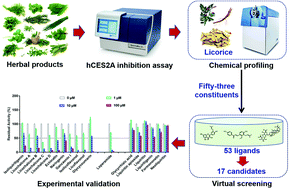Discovery of hCES2A inhibitors from Glycyrrhiza inflata via combination of docking-based virtual screening and fluorescence-based inhibition assays†
Abstract
Human carboxylesterase 2 (hCES2A) is a key target to ameliorate the intestinal toxicity triggered by irinotecan that causes severe diarrhea in 50%–80% of patients receiving this anticancer agent. Herbal medicines are frequently used for the prevention and treatment of the intestinal toxicity of irinotecan, but it is very hard to find strong hCES2A inhibitors from herbal medicines in an efficient way. Herein, an integrated strategy via combination of chemical profiling, docking-based virtual screening and fluorescence-based high-throughput inhibitor screening assays was utilized. Following the screening of a total of 73 herbal products, licorice (the dried root of Glycyrrhiza species) was found with the most potent hCES2A inhibition activity. Further investigation revealed that the chalcones and several flavonols in licorice displayed strong hCES2A inhibition activities, while isoliquiritigenin, echinatin, naringenin, gancaonin I and glycycoumarin exhibited moderate inhibition of hCES2A. Inhibition kinetic analysis demonstrated that licochalcone A, licochalcone C, licochalcone D and isolicoflavonol potently inhibited hCES2A-mediated fluorescein diacetate hydrolysis in a reversible and mixed inhibition manner, with Ki values less than 1.0 μM. Further investigations demonstrated that licochalcone C, the most potent hCES2A inhibitor identified from licorice, dose-dependently inhibited intracellular hCES2A in living HepG2 cells. In summary, this study proposed an integrated strategy to find hCES2A inhibitors from herbal medicines, and our findings suggested that the chalcones and isolicoflavonol in licorice were the key ingredients responsible for hCES2A inhibition, which would be very helpful to develop new herbal remedies or drugs for ameliorating hCES2A-associated drug toxicity.



 Please wait while we load your content...
Please wait while we load your content...